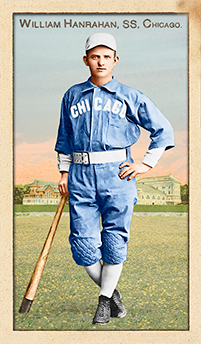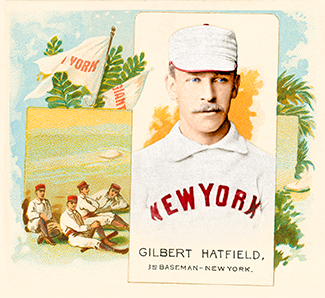
- Series: 1880s: Loving Paupers
- City: Cleveland
- Team: Blues (AA)
- League: American Association
Mortimer Edward Hogan (1862-1923) broke into pro ball in 1883 with the Peoria Reds. The young outfielder got the first of two shots at the big time the following season with the Milwaukee Brewers of the soon-to-be-defunct Union Association. Even had the league survived that turbulent year, it is virtually certain that Hogan's .081 batting average would have doomed him to return to the minors. He spent most of '84 with the Milwaukee Northwestern League club after the UA went belly up. Hogan at least hit his weight here, bumping his average up to .217. The light-hitting Hogan remained in the minors, bouncing from the Southern League to the Western League and to Elmira of the New York State League before returning south to two Georgia squads for most of the '86 season. He moved back to the WL's Leavenworth Soldiers to finish the campaign before getting another opportunity in the majors with the American Association's New York Metropolitans where his .200 average might have been overlooked as the team struggled to a 45-88 record and a dismal seventh place finish. Well, apparently Mort's weak hitting wasn't ignored as the woeful Mets shipped him to Nashville to finish out the '87 season. But all was not dark for Hogan as he was given one last chance at big league glory with the 1888 Cleveland Blues of the AA, where he managed a .227 average. The Cleveland management, having witnessed the futility of Hogan and the Mets the prior year, still held out hope, signaling the eternal optimism that defines America's pastime.
- Perhaps Mortimer had the last laugh as the Blues managed a sixth place finish in '88, an improvement that launched Hogan into retirement at the age of 26
Auction History
Cartophilia
Old Judge Pose: 229-5

- Series: Beginnings: 1880's
- City: Boston
- Team: Beaneaters
- League: National League
Michael Joseph Hornung (1857-1931) made a lasting impression in the baseball world of his day on at least two grounds. Most noteworthy, he was perhaps the premier defensive outfielder of the 1880s. His sure-handedness allowed him to lead the National League in fielding percentage in 1881, ‘82, ‘83 and ‘86. The second basis of notoriety for Hornung was what must have been a very annoying habit. He would shout “ubbo, ubbo!” whenever he got a hit or made a play he fancied. Since he hit a respectable .257 over his twelve-year career, and made just about all the plays that came his way in the no-glove era, the ballparks of the day must have resounded with many an “ubbo.” His antics led to his nickname Ubbo Ubbo, which meant others beside himself were uttering the gibberish all too frequently.
Joe had begun his pro career in Canada with the London (Ontario) Tecumsehs in 1876. His major league debut was with the Buffalo Bisons in 1879 and in '81 made the move to Boston which would be his home through the 1888 season. The colorful star's performance declined and the Beaneaters tried to sell him to the White Stockings. The veteran balked, insisting on a piece of the $5000 price, and was rewarded by being ousted from the league. The American Association's Orioles welcomed Joe and he played one year on a bad leg before ending his big league career in 1890 with the Giants. His speed had been an asset afield and on the bases. Hornung was a renowned base-stealer, usually among the leaders in triples, and led the NL in scoring in 1883.
- Ubbo Ubbo's popularity was such that the vaunted '27 Yankees honored him on his June 12 birthday at the stadium. Ruth, Gehrig, Lazzeri and all serenaded Joe and he received a “nice check” from players who remembered him fondly as one of the greats.
- His hometown Utica paper hailed him as “King of the Left Fielders” and “just as much a baseball hero as Ty Cobb, Babe Ruth or Tris Speaker is today.”

- Series: Beginnings: 1880's
- City: Chicago
- Team: Maroons
- League: Western Association
Emery J. Hengel (1857-1924) had brief stints in major league baseball during parts of the 1884 and 1885 seasons. Moxie signed on as an infielder with his hometown's entry in the upstart Union Association, whose Browns sought to compete with the renowned Chicago White Stockings. The experiment failed and, by August, the club had moved to Pittsburgh (as the Stogies) and lasted until September 18. Many of the players went to Baltimore's Monumentals, but Hengel landed in the Twin Cities with the St. Paul Saints (White Caps). That franchise's contribution to the UA amounted to eight games in total, all on the road. Moxie's anemic .152 average might have signaled a quick end to his would-be career, but he got one more chance - this time with the National League's Buffalo Bisons in what would be their final campaign in the majors. That 1885 season saw Hengel teaming with some real stars: first baseman Dan Brouthers, second baseman Davy Force, shortstop Jack Rowe, third baseman Deacon White, outfielder Hardy Richardson and pitcher-manager Pud Galvin were all on hand. Despite all that talent, the Bisons ended the year ahead of only the woeful St. Louis Maroons and were folded into the Detroit Wolverine club the following season. By this time, Moxie had achieved the dubious distinction of having been on the final rosters of four straight failed ball clubs within two years - and Moxie's days in the Show were over. Undeterred, Hengel returned to the minors, playing for the Utica Pent-Ups, Chicago Maroons, Minneapolis Millers and others before closing his pro tenure with the Minneapolis Minnies of the Western League in 1894 at age 36. In '92 Moxie made a stop in Michigan with the Ishpeming-Negaunee Unions of the Wisconsin-Michigan League, a team that, thankfully, never had to recruit a radio broadcaster.
- Moxie's first major league manager was Ed Hengel. One of three managers for the Chicago Browns in 1884, Ed managed the team to 34 wins and 39 losses. Ed was also born in Chicago and just two years before Moxie. While it's hard to imagine the two were not related, research has not revealed any familial connection.
- Moxie's batting average for his three big league teams was .180. He hit no home runs but did manage three doubles and two triples in his 35 games
- Moxie may have been a better leader than ballplayer: He managed the Chicago Maroons in 1888 and the Minneapolis Millers (road games only) in 1889
- The first release of this card (January, 2017) was likely an error: Hengel was misspelled as "Hengle." This is actually a common mistake for Moxie and it has caused a fair amount of confusion through the years. The Old Judge editors spelled his name "Hengle" and his Wikipedia entry uses the two spellings interchangeably. Deeper research indicates that "Hengel" is the most likely spelling. All subsequent releases of this card will feature the name "Hengel."
- Series: 1888 Champion New York Giants
- City: New York
- Team: Giants
- League: National League
Gilbert Hatfield (1855-1921). A pitcher and infielder for 6 teams over 8 seasons, Hatfield did not break into the majors until the age of 30 – then played sporadically across the next decade – actually getting into 5 games with Louisville at the age of 40.
Hatfield was a member of the 1888 World Series Champion New York Giants. As a hitter, Hatfield went 2-8 in the series with 1 BB, 1 RBI & 1 Run. As a pitcher, Hatfield made 1 relief appearance, giving up 12 hits & 12 runs (7 earned) in 5 innings.

- Series: Beginnings: 1880's
- City: Chicago
- Team: White Stockings
- League: National League
William T. Hanrahan, nicknamed “Red,” played minor league ball from 1885 through 1898, primarily in the Western Association and the Eastern League. He began with Albany of the New York State League but moved west to Chicago in 1888, presumably to make his bid to play major league baseball in the National League.
The shortstop was photographed by Old Judge that year in a Chicago White Stockings uniform. However, Red never played for the team and is identified by Goodwin instead as a member of the Chicago Maroons in 1888 and the Minneapolis Millers in 1889. This makes Red one of a handful of Old Judge subjects who was lucky enough to be on a major league roster the day the Goodwin photographers showed up, but unlucky enough to be removed from the roster without ever having played a game for that or any other major league team. So close, Red! So close.
Red was a regular with both the Maroons and Millers, playing in over a hundred games for both clubs. The sketchy minor league stats don’t record every campaign, but he seems to have generally batted under .300, faring better in the 1890s when he returned east. He hit .307 with Albany in ‘93 and .306 with Rochester in ‘96. By then his plate appearances were in decline, getting into only 16 games with the Browns. Red’s final season brought his pro ball career full-circle as he wrapped it up with the Johnstown/Palmyra Mormans (aka Johnnies) of a newly reconstituted NY State League in 1898, which now included Pennsylvania teams.
- The Maroons and Millers were led by manager Moxie Hengel, the only two seasons he managed in pro ball. With Minneapolis, Moxie shared managerial duties with Sam Morton. It is said the two had a strange method, Hengel piloting the road games and Morton serving as the home field boss
- As a rule of thumb in the 1880s series, I always designate a player’s team as that for which he is uniformed in the photograph, even if he never played for the team.




